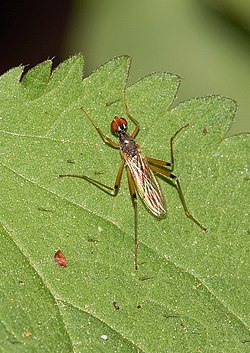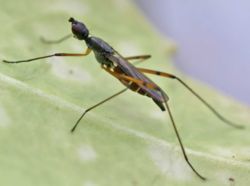Stilt flies
| Stilt flies | ||||||||||||
|---|---|---|---|---|---|---|---|---|---|---|---|---|

Stilt fly, probably Neria cibaria |
||||||||||||
| Systematics | ||||||||||||
|
||||||||||||
| Scientific name | ||||||||||||
| Micropezidae | ||||||||||||
| Loew , 1861 | ||||||||||||
| Subfamilies | ||||||||||||
|
The stilt flies or stilt flies (Micropezidae) are a family of the two-winged flies (Diptera). Around 470 species are known worldwide, of which 22 in Europe and 13 in Germany . The following are synonymous: Calobatidae, Taeniapteridae, Tylidae and Trepidariidae. There are currently 5 subfamilies with 40 genera.
The family shows its main distribution in the tropics and subtropics . The animals are usually found in damp places, where they sit on leaves or flowers or walk around like stilts.
features
The colloquial name refers to the particularly long legs that support the body like stilts. These are not infrequently also specially colored or provided with tufts of hair. The body is elongated, the head is flattened dorso-ventrally with a large forehead. Similar to the bladder-head flies (Conopidae), the male reproductive system is folded forward ventrally and can be clearly seen. The females have a dagger-like egg-laying apparatus ( ovipositor ). The wings are drawn in several species.
Way of life
Little is known about the way of life of the larvae ; they appear to be phytophagous or saprophagous . Some larvae and adults could be discovered on rotting mushrooms . The larvae of Micropeza corrigiolata burrow into the roots of Fabaceae .
The adult animals ( imagines ) are either robber small insects or settle on excrements and ripe fruit.
The behavior of the males from sitting is particularly remarkable. While the body remains at rest, the animals move their mostly prominent front legs through the air. Possibly it is an advertising behavior.
Systematics
The following genera and species are native to Europe:
Genus Calobata [= Trepidaria ]
- Calobata petronella (Linnaeus 1761) [= Trepidaria ]
Genus Cnodacophora
- Cnodacophora sellata (Meigen 1826) [= adusta (Loew, 1870)]
- Cnodacophora stylifera (Loew 1870)
Genus Micropeza [= Tylos ]
- Micropeza angustipennis Loew 1868
- Micropeza atripes Bezzi 1895
- Micropeza brevipennis by Roser 1840
- Micropeza cingulata Loew 1868
- Micropeza corrigiolata (Linnaeus 1767)
- Micropeza grallatrix Loew 1868
- Micropeza hispanica Bigot 1886
- Micropeza kawalii Gimmerthal 1847
- Micropeza lateralis Meigen 1826
Genus Neria [= Calobatella , Compsobata ]
- Neria cibaria (Linnaeus 1761)
- Neria commutata (Czerny 1930) [= nigricornis auct., Nec. (Zetterstedt, 1838)]
- Neria dentigera (Loew 1854)
- Neria ephippium (Fabricius 1794)
- Neria femoralis (Meigen 1826)
- Neria longiceps (Loew 1870)
- Neria nigricornis (Zetterstedt 1838)
- Neria octoannulata (Strobl 1899)
Genus Rainieria
- Rainieria calceata (Fallén 1820)
- Rainieria latifrons (Loew 1870)
The Australian species are divided as follows:
Subfamily Calycopteryginae
- Genus Calycopteryx
Subfamily Eurybatinae
- Tribe Metopochetini
- Genus Metopochetus
- Genus Badisis
- Tribe Eurybatini
- Genus Cothornobata
- Genus Crepidochetus
Subfamily Taeniapterinae
- Genus Mimegralla
Fossil evidence
Fossil stilt flies are only known from inclusions in the amber of tertiary deposits, but even here extremely rare. The few species described come from Eocene Baltic amber . In addition, unspecified members of the family were found in the somewhat younger Mexican and Sicilian amber .
literature
- J. & H. Haupt: Flies and mosquitoes - observation, way of life. Augsburg 1998, ISBN 3-89440-278-4 .
- A. Stark: Micropezidae. In: H. Schumann, R. Bährmann, A. Stark (eds.): Checklist of the Diptera in Germany. In: Studia dipterologica. Supplement 2, Halle / Saale 1999, p. 160.
Individual evidence
- ^ David K. McAlpine: Review of the Australian stilt flies (Diptera: Micropezidae) with a phylogenetic analysis of the family. In: Invertebrate Taxonomy. 12, 1998, pp. 55-134.
- ↑ George O. Poinar, Jr .: Life in Amber. Stanford University Press, Stanford (Cal.) 1992, ISBN 0-8047-2001-0 .
- ↑ http://hbs.bishopmuseum.org/fossilcat/fossmicropez.html fossil Diptera


